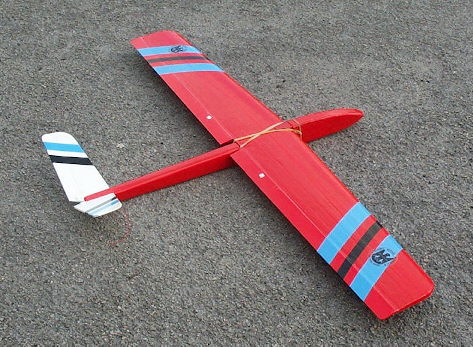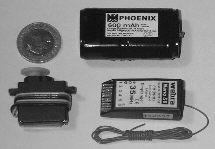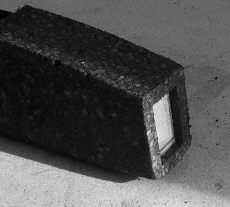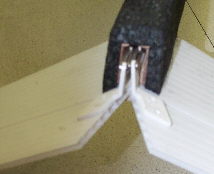|
 About Us
About Us
Read
about PMP's history and philosophies
 What We Sell
What We Sell
View a full listing of products sold by PMP
 Shopping at PMP
Shopping at PMP
An
overview of shopping at PMP
 Newsletters Newsletters
 Come Visit Us
Come Visit Us
We
are always happy for modellers to drop in and shop. Here are directions,
give us a call to let us know you're coming.
 Agents/Suppliers for:-
Agents/Suppliers for:-
|
|
Rico
- SHE & Rico - SHE LW
60in EPP
Crash Resistant Pylon Racer / Sports Aerobatic Slope Soarer
Designed
by Stan Yeo
Produced
by PHOENIX MODEL PRODUCTS
Introduction

The Rico-SHE
is a stylish 60in EPP pylon racer I sports aerobatic sloper designed to
meet the demand for more crash resistant pylon racers and conform to the
new 6Oin EPP pylon racing class. It is intended that Rico-SHE is built
with wing mounted aileron servos with the ailerons being used as flapperons
with elevator flap coupling. In this mode Rico-SHE can perform must aerobatic
manoeuvres including outside loops, horizontal eights and sustained inverted
flight etc. As with all EPP models building time has been kept to a minimum;
typically 8 -12 hrs depending on the skill and care taken. Field repairs
are of the Elastoplast variety! Tools / Materials Required The only tools
required are a modelling knife with spare blades, a pair of sharp scissors,
180 grade Wet & Dry sanding block, a tube of impact adhesive such as Evo-Stik,
some runny super glue (please observe safety precautions on packets!),
epoxy and a soldering iron.
R/C
Equipment
The R/C Equipment used in the prototypes consisted of three metal gear micro servos (HS81MG) a 2/3 AF size Rx flat Nicad pack plus a Webra 6/
JR R700 7 channel Rx. All the items are available from PMP at competitive
prices.
micro servos (HS81MG) a 2/3 AF size Rx flat Nicad pack plus a Webra 6/
JR R700 7 channel Rx. All the items are available from PMP at competitive
prices.
Building
the Fuselage
- Lightly
sand the fuselage sides, top and bottom with 180 grade wet and dry to
remove the 'release' agent. Remove dust with a small brush or vacuum
cleaner. NOTE: If building the lightweight fuselage attach wingseat
reinforcement to inside of fuselage sides. Also the top balsa blocks
attached to these doublers are 1.5mm shorter than the front fuselage
blocks.
- Drill
wing dowel holes in fuselage sides and fit fuselage distance pieces
and nose former to one fuselage side.
- Fit 4.5mm
sq. strip, tail seat and triangular nose strip to fuselage. Check you
have a left and right side!
- Join
fuselage sides together over plan ensuring fuselage is straight. Cut
nose top to length and fit.
- Cut fuselage
top to length and glue in position.
- Fit elevator
servo to balsa bearers and determine which side of servo the elevator
pushrod needs to be for the elevator to operate in the correct sense!
Position inside fuselage. Dry fit elevator control rod. Position elevator
servo in fuselage and cut elevator pushrod level with hinge line of
elevator minus 45mm or 1.75inches to allow for threaded adaptor and
metal clevis.
- Remove
pushrod and fit outer sleeve if not already fitted and fit the second
elevator push rod to primary push rod as per the plan.
- Fit threaded
adapters and metal devises. DO NOT use locknuts on devises.
- Refit
elevator pushrod. Reposition servo and anchor pushrod conduit to fuselage
side near the conduit ends ensuring there is sufficient
control rod movement and does not bottom out at the push rod 'Y' joint.
- Do not
glue elevator servo in position until after the tailplane is fitted.
- Fit fuselage
bottom and trim to length. Drill hole for ballast bolts. Reinforce corner
joints with 25mm wide strips of CW tape.
- Spray
the fuselage and EPP sides with spray on adhesive. When solvent has
evaporated fit together and trim EPP flush with side but the nose former.
Here 10mm is left on all four sides to form a cavity for nose weight.
At the tailplane seat trim the EPP to the Vee tail angle.
- Trimming
the EPP is best done with a long bladed (X-Acto or similar) knife using
the fuselage top & bottom as a guide.
- Fit the
EPP fuselage bottom as before and trim the EPP again using fuselage
side as knife guide.
-
Fit EPP fuselage top (Front & Back). Round fuselage corners.
- Glue
6ograms or 2 ozs. of lead to front of nose former in cavity formed by
EPP sides. Fit nose block and shape fuselage i.e. round corners using
sharp knife and 180 grade wet & Dry (use dry!).
- Mark
centreline of tailplane and remove a triangular strip from top side
to allow tail to bend to 120 degree angle. Superglue balsa tail gusset
in position to lock tailplane at required angle.
- Mark
elevator hinge line on tailplane and remove strip of plastic on one
side to form hinge.
- With
hinge line uppermost, mark centre line of tailplane and cut V slot to
allow Tailplane to be folded to 120 degree angle. Super glue balsa triangular
TP centre brace in place.

- Glue
tailplane to fuselage using Epoxy.
- Make
hatch, shape and cover with CW tape.
- Cover
fuselage using CW tape. Overlap each strip by 6 - 10 mm or 1/4 to 318
inch. In high stress areas such the under the wing leading and trailing
edges apply an extra layer of tape for added strength.
Building
the Wings.
- Lightly
sand wing surfaces and remove dust as before. Trim and sand spar slots
to accommodate mainspars. Unfortunately cutting tapered wings with spar
slots result in a tapered spar slot. Remove waste from wing brace slot.
- Fit top
wing spars using Epoxy. Cut to length.
- Fit 3mm
bass trailing edges using Epoxy. Use masking tape to hold in position
whilst Epoxy sets.
- With
wing upside down fit wing brace and bottom wing spars. Note trailing
edges should form a straight line i.e. not be swept back or forward.
Trim spars to length and shape wing tips.
- Laminate
ply rear wing braces and Epoxy in position noting orientation of taper.
- Mark
position of wing servos (plan drawing is full size. Outboard position
of servo is dependant on servo lead length. Note servo arms both point
outboard of wing.
- Cut rectangular
hole for servo in wing ignoring servo mounting lugs. Note it may be
necessary to remove the mounting lugs of the servo.
- Using
Hacksaw blade cut slot in EPP for servo lugs and fit servo so
that it is flush
with bottom of wing. Note gap between top of servo and top of wing.
From block of EPP removed for servo from wing slice off the required
amount and fit in this void.
- Remove
wing servos for covering.
- Spray
wing with spray adhesive and cover wing with GW tape. Start by laying
strip along TE. Then work forward overlapping the previous strip by
6-10mm. At the leading edge trim tape as you would if covering in film
but overlapping top and bottom by 10mm. Cover top surface of wing with
coloured vinyl tape I lightweight Fablon or iron on film. This serves
two purposes, one to decorate model, the second to reduce the effects
of ultra violet light on the CW tape.
- After
covering fit aileron servos. Cut vertical slot in wing to hide servo
leads.
- Cut ailerons
to size and shape aileron leading edge. Note the ailerons are top hinged
using Diamond Sellotape. Cover the ailerons, starting at TE using either
an iron on film or coloured vinyl tape used to decorate wing.
- Using
scrap wing sleeving manufacture wing fairing, cover and
 double
side tape in position. double
side tape in position.
- Fit control
linkages and adjust to obtain required throws (see flying section).
DO NOT replace the plastic mini-snaplinks with metal devises. In the
event of a mishap the plastic snaplinks will break thereby reducing
the risk of damage to the aileron servos.
Performance
Tweeks
A number
minor of 'modifications' can be made to the Rico-SHE to enhance the model's
performance for competition and sports flying. They are not listed as
standard as most sports flyers would opt for durability and the simple
approach.
- The Correx
tail can be replaced with 4.5mm balsa sheet and the angle reduced to
110 degrees to marginally improve directional stability at the expense
of longitudinal (pitch) stability. If the Correx tail is replaced with
balsa we recommend that it is bolted on and a spare is carried rather
than being glued on as any damage to the tail could easily result in
the model being decommissioned.
- The aileron
hinge gap can be sealed with Mylar strip (draughting film) and aerodynamic
shrouds fitted over the aileron push rods.
- A bolt
on wing system can be used instead of rubber bands.
- Appropriate
ballast is used whenever the conditions permit but
please remember that if carrying ballast allow a little more airspace
to carry out manoeuvres and avoid over control.
- Couple
the flap and elevator so that when turning or looping etc. the wing
can produce the extra lift required more efficiently.
- By far
the biggest impact on a model's performance is the pilot! Practice makes
perfect. Fly Rico-SHE in as wide as conditions as possible and as often
as possible, with and without ballast.
Flying
- Set the controls to give the following movements for initial flights:
- Ailerons +/- 12 mm
- Elevator +/- 8 mm
- Flapperons +/- 5mm
- Balance Point 75mm +1- 5mm from LE
- Adjust balance to within recommended limits. Prototypes required
50 - 8ogms of lead in the nose. Check alignment of wing and tailplane
and wing to tailplane incidence (chord lines should be parallel). Laterally
balance wing and check that it is not twisted. If the wing is twisted,
twist back in the required direction and re-smooth covering tape in
position. If model is fitted with flapperons check zero flap is in fact
zero flap otherwise performance will be impaired!
- Depending on the control functions installed will depend the aerobatic
potential of the Rico-SHE. Remember all aerobatic manoeuvres require
energy to perform a manoeuvres. If the model has insufficient speed
it will fall out of the manoeuvre or perform it half-heartedly. Vertical
or near vertical dives are not an efficient way to build up speed, 20-
30 degree dives are much more efficient. Avoid sudden control inputs.
In most cases all they do is scrub off speed and lose height. Try to
fly smoothly with the minimum of control input as not only do the manoeuvres
look better but you will be able to perform more of them before having
to regain height. Try stringing manoeuvres together paying particular
attention to positioning. Be creative and set yourself targets for each
flying session.
- To check the elevators have no in-built rudder trim carry out a series
of loops into wind and note whether the tail remains into wind and or
attempts to 'screw out of the loop. Adjust elevators individually as
necessary.
- If the lift is good or you are having difficulty penetrating into
wind try ballasting the model. This will increase penetration and help
the model maintain speed through manoeuvres. Note when adding ballast
take care not to disturb the balance point. We have found the optimum
ballast to be 8 ounces or 225 grams. Take care when adding ballast as
over-ballasting can lead to tip stalling and a degradation in performance.
- The suggested control settings are a starting point and can be adjusted
to suit your personal tastes. Adjust the balance point so that when
the model is trimmed the elevator is more or less in the neutral position.
An indication that it is about right can be gauged by the amount of
down elevator required to maintain inverted flight. Please remember
if the balance point is moved from the design position it will alter
the elevator neutral position and will necessitate re-rigging the tailplane
to return the elevator to neutral.
- If you are using a computerised transmitter program in positive Exponential
on the Aileron and Elevator controls. This will 'soften' the controls
around the neutral position and facilitate smoother flying particularly
on the elevator control.
- Rico-SHE will take a lot of punishment. It is excellent for building
confidence and will add another dimension to your flying but please
remember if you take a big enough hammer to anything it will break particularly
the lightweight fuselage version. The CW tape used for covering also
degrades in ultra-violet light so store the model in a relatively cool
place away from direct sunlight.
- The RGI5 wing section is very efficient and performs well in light
lift so with good ballast selection Rico-SHE will cope with most wind
I lift conditions.
- Finally should you require further assistance or advice please contact
us either by letter, telephone, email or visit our website (http://www.phoenixmp.com)
where you will find useful information on sloping etc.
Happy flying
Stan Yeo
Rico-SHE
010130
|
|